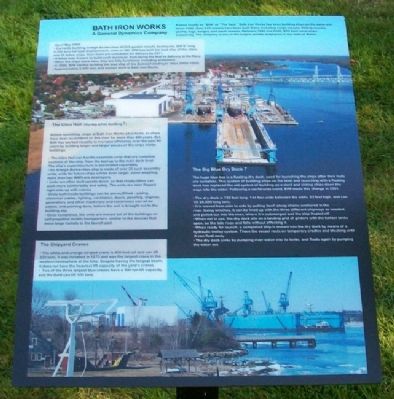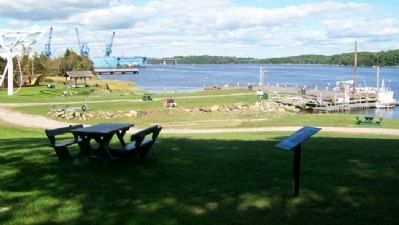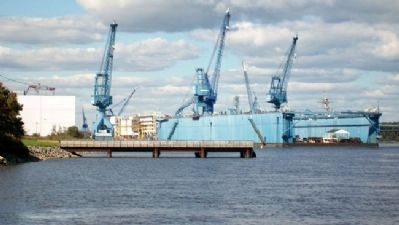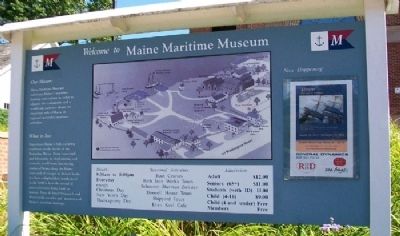Bath in Sagadahoc County, Maine — The American Northeast (New England)
Bath Iron Works
A General Dynamics Company
Known locally as "BIW" or "The Yard," Bath Iron Works has been building ships on the same site since 1890. Over 420 vessels have been built there, including cargo vessels, fishing vessels, yachts, tugs, barges, and naval vessels. Between 1984 and 2009, BIW built naval ships exclusively. The company is one of the largest private employers in the state of Maine.
As of May 2009:
Currently building Arleigh Burke-class AEGIS guided missile destroyers, 509'6" long, 9,200 tons full load displacement, crew of 380. BIW has built the lead ship of this class, and 29 follow ships. Four more are scheduled for delivery by 2011.
It takes over 3 years to build each destroyer, from laying the keel to delivery to the Navy.
When the ships leave here, they are fully functional, including armament.
In 2009, BIW started building the lead ship of the Zumwalt destroyer class (DDG-1000).
Approximately 5,600 men and women work at Bath Iron Works.
The Ultra Hall (the big white building)
Before launching, ships at Bath Iron Works sit outside, as ships have been assembled on this river for more than 400 years. But BIW has worked steadily to increase efficiency over the past 60 years by building larger and larger pieces of the ships inside buildings.
The Ultra Hall can handle assembly units that are complete sections of the ship, from the keel up to the main deck level.
An Arleigh Burke-class ship is made of over 20 such assembly units; units for future ships will be even larger, some weighing more than two WWII-era destroyers.
Units are often built upside-down, so that shipubilders can work more comfortably and safely. The units are later flipped right-side up with cranes.
Units built inside buildings can be pre-outfitted - piping, electrical cables, lighting, ventilation, doors, paneling, engines, generators, and other machinery and electronics can all be added, and painting done, before the unit is brought out to the building slip.
Once completed, the units are moved out of the buildings on self-propelled mobile transporters, similar to the devices that move large rockets to the launch pad.
The Big Blue Dry Dock
The huge blue box is a floating dry dock, used for launching the ships after their hulls are complete. This system of building ships on the level and launching with a floating dock has replaced the old system on a slant and sliding ships down the ways into the water. Following a world-wide trend, BIW made this change in 2001.
The dry dock is 750 feet long, 144 feet wide between the walls, 52 feet high, and can lift 28,000 long
tons.
It is moved from side to side by pulling itself along chains anchored in the river. Using winches, it can be lined up with the three different shipways as needed, and pulled out into the river, where it is submerged and the ship floated off.
When not in use, the dry dock sits on a landing grid of girders with the ballast tanks open, so the tide rises and falls without affecting it.
When ready for launch, a completed ship is moved into the dry dock by means of a hydraulic trolley system. There the vessel rests on temporary cradles and blocking until it can float away.
The dry dock sinks by pumping river water into its tanks, and floats again by pumping the water out.
The Shipyard Cranes
The white-and-orange-striped crane is 400 feet tall and can lift 220 tons. It was installed in 1973 and was the largest crane in the western hemisphere at the time. Despite having the longest boom, it does not have the heaviest lift capacity of the yard's cranes.
Two of the three largest blue cranes have a 300-ton lift capacity, and the third can lift 100 tons.
Erected 2009 by Maine Maritime Museum and Bath Iron Works.
Topics. This historical marker is listed in these topic lists: Industry & Commerce • Waterways & Vessels. A significant historical month for this entry is May 2009.
Location.
43° 53.659′ N, 69° 48.928′ W. Marker is in Bath, Maine, in Sagadahoc County. Marker is on the grounds of the Maine Maritime Museum, 243 Washington Street. Touch for map. Marker is in this post office area: Bath ME 04530, United States of America. Touch for directions.
Other nearby markers. At least 8 other markers are within walking distance of this marker. Wyoming Sculpture (a few steps from this marker); The Pitch Oven (1902) (within shouting distance of this marker); The Caulkers' Shed (1899) (within shouting distance of this marker); Site of the South Ways (ca. 1867) (within shouting distance of this marker); The Mould Loft (1917) (within shouting distance of this marker); The Fitting-Out Pier (1906) (within shouting distance of this marker); a different marker also named Wyoming Sculpture (within shouting distance of this marker); Site of the North Ways (1901) (about 300 feet away, measured in a direct line). Touch for a list and map of all markers in Bath.
More about this marker. The Maine Maritime Museum is on the grounds of the former Percy & Small Shipyard, which was the last remaining intact wooden sailing vessel shipyard in the United States.
Also see . . .
1. Bath Iron Works. (Submitted on January 28, 2012, by William Fischer, Jr. of Scranton, Pennsylvania.)
2. Maine Maritime Museum. (Submitted on January 28, 2012, by William Fischer, Jr. of Scranton, Pennsylvania.)
3. Bath Iron Works at Wikipedia. (Submitted on January 28, 2012, by William Fischer, Jr. of Scranton, Pennsylvania.)
Credits. This page was last revised on June 16, 2016. It was originally submitted on January 28, 2012, by William Fischer, Jr. of Scranton, Pennsylvania. This page has been viewed 1,566 times since then and 92 times this year. Photos: 1, 2. submitted on January 28, 2012, by William Fischer, Jr. of Scranton, Pennsylvania. 3. submitted on January 29, 2012, by William Fischer, Jr. of Scranton, Pennsylvania. 4. submitted on January 27, 2012, by William Fischer, Jr. of Scranton, Pennsylvania.



